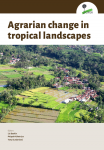‘Agrarian change in tropical landscapes' documents the results of a research project that explored what happens when significant environmental change occurs in forested tropical landscapes, primarily driven by agricultural development.
Coordinated by the Center for International Forestry Research (CIFOR), a member of the CGIAR Consortium, the Agrarian Change project conducted in-depth studies of seven landscapes around the world that exhibit various scenarios of changing forest cover, agricultural modification, and integration with local and global commodity markets.
 February 2016: A new publication, titled ‘Agrarian change in tropical landscapes,’ documents the results of a research project that explored what happens when significant environmental change occurs in forested tropical landscapes, primarily driven by agricultural development. Coordinated by the Center for International Forestry Research (CIFOR), a member of the CGIAR Consortium, the Agrarian Change project conducted in-depth studies of seven landscapes around the world that exhibit various scenarios of changing forest cover, agricultural modification, and integration with local and global commodity markets.
February 2016: A new publication, titled ‘Agrarian change in tropical landscapes,’ documents the results of a research project that explored what happens when significant environmental change occurs in forested tropical landscapes, primarily driven by agricultural development. Coordinated by the Center for International Forestry Research (CIFOR), a member of the CGIAR Consortium, the Agrarian Change project conducted in-depth studies of seven landscapes around the world that exhibit various scenarios of changing forest cover, agricultural modification, and integration with local and global commodity markets.
One of the central questions explored in the book is whether the drive to increase agricultural intensification, especially to meet global demand for food and agricultural commodities, justifies the wider costs linked to the rapid fragmentation of forest habitats. The Agrarian Change project tackles this issue by examining the socioeconomic outcomes, as well as the conservation, livelihood and food security implications of land-use change and agrarian change processes in multi-functional landscapes. Specifically, the study examines relationships between agricultural production and trade-offs or synergies with landscape components such as local food security, dietary diversity and nutrition levels, market access, tenure, local poverty, and biodiversity conservation.
The bulk of the publication is structured around seven chapters, corresponding to in-depth studies of forested landscapes in Ethiopia, Cameroon, Indonesia, Nicaragua, Bangladesh, Zambia and Burkina Faso. Each case study chapter describes the physical and socioeconomic context of the focal landscape and explains the historical and political drivers of land-use change occurring in the area. While the country studies represent a diversity of forest types, levels of biodiversity, agricultural practices and market influence, the authors note that a common characteristic is that all seven landscapes “exemplify clear gradients of agricultural expansion and intensification.” Some of the land-use transitions described in the book include: moving from a cash cropping system to cocoa agroforestry regimes and a commercial oil palm system in Cameroon; transitioning from subsistence agriculture to a local market-oriented cash-cropping system and then to an extensive commercially-driven wheat arrangement in Ethiopia; and changing from a subsistence farming scenario (with high dependency of communities on forest products) into a rubber agroforestry and swidden agriculture system, which then transitions into a commercial oil palm system in Indonesia.
The book also highlights a follow up empirical study that is underway in the seven landscapes to provide more insights into how landscape-scale land-use trajectories manifest in local communities, and to advance understanding of multi-functional landscapes as socioecological systems. [CIFOR Announcement] [Publication: Agrarian Change in Tropical Landscapes]